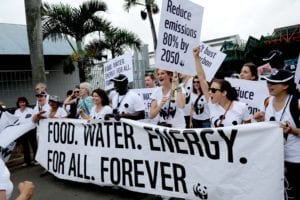The recent Conference of Parties, COP 17, meeting in Durban was its usual rollercoaster ride, ending with a surprise commitment by most of the 200 countries which took part to continue the Kyoto Protocol, along with a draft of other climate change agreements. While the outcome has signalled a breakthrough for a political consensus on climate change, the outcome for business is only just becoming clear
The expectations, the outcomes, and the effect on business At one point, the COP 17 meeting in Durban looked as if it was heading for disaster. Now that it is over, it is clear that the world is still heading in the right direction in terms of its approach to dealing with climate change and that it is more firmly committed to a low carbon path than it was before the meeting. The UNFCCC process, although slow and beset with challenges, is moving forward. Expectations for Durban were very low, but in spite of this, the conference led to a significant breakthrough that will have important consequences for businesses around the world. Slowly but surely, like it or not, the world is moving forward on climate change, with business now able to seriously calculate the implications of a low carbon economy. The Kyoto Protocol has been given a second lease of life and will now operate within the context of a broader approach to tackling climate change that will, for the first time, include all the major emitters. This is a crucial point which will impact many of the largest business operators around the world and many smaller businesses further down the supply chain. There will be a second commitment period to start from 2013, meaning that all of the treaty’s rules, mechanisms and markets will remain in force. Business can be confident that market-based mechanisms such as the Clean Development Mechanism (CDM) will continue. But more importantly, there is a commitment to a new legal, global instrument to be approved by 2015 and planned to take effect by 2020. As a result, an international agreement for global action on climate change is within our reach and should therefore be considered within every forward looking business strategy.
KYOTO PROTOCOL AND COP 17 – THE OUTCOME
The world’s climate change community travelled to Durban for the COP 17 climate conference with expectations set very low. The prospects for the Kyoto Protocol looked bleak, and as a result there was great uncertainty over the future of the CDM and Joint Implementation carbon markets. Key players seemed set on apparently irreconcilable positions, with many developing countries insisting that Kyoto must continue at all costs while countries such as Russia, Japan and Canada were equally adamant that they would not get involved in a second commitment period. The two largest emitters, China and the US, seemed as far apart as ever, while the key cheerleader for the process, the EU, appeared absorbed by its internal financial problems and was still smarting from the disappointments of Copenhagen. The whole UNFCCC process was in danger of becoming an irrelevant sideshow. Yet as Durban headed into the final weekend, rumours started to circulate that a deal would happen – and a significant one at that. And finally, some 36 hours after the conference was due to end – and after a few heads had been metaphorically knocked together – an agreement was reached. The Kyoto Protocol has been given a second lease on life and it will now operate within the context of a broader approach to tackling climate change that will, for the first time, include all the major emitters. There will be a second commitment period, to start from 2013, meaning that all of the treaty’s rules, mechanisms and markets will remain in force. Business can have confidence that market-based mechanisms such as the CDM will continue. 2015 and beyond
With a pinch of luck, by 2015 the current economic crisis will be behind us, creating a more benign climate for governments to make commitments the world needs in order to tackle climate change effectively and business needs to survive and prosper. In addition, the 2015 deal will take place against the background of a new assessment by the scientific community to be published in 2014 that is likely to deliver a wake-up call for us all: while the rhetoric has been very impressive, our concrete actions have not taken us anywhere near where we need to be to keep temperature rises to below 2ºC.
The Durban conference means that the deadlines for approval and implementation of the agreement have been settled, but its exact nature remains open to interpretation. The new working group created to formulate the agreement therefore has a crucial role to play in building on the solid advances that emerged from the conference. We need urgent clarity on the legal nature of the outcome and the targets that will be involved for the various parties.
Important progress was also made on the establishment of the Green Climate Fund which aims to mobilise US$100 billion annually to help developing nations reduce emissions and adapt to the effects of a warming climate. Prior to the conference it was unclear what role business would play in the fund; the worry was that the private sector would be sidelined. Thankfully, Durban saw confirmation that the Fund will have a facility to fund private sector initiatives. It will seek actively to promote business involvement and catalyse further public and private money. This approach could see public-private partnerships in developing nations acting as vehicles for sustainable growth. Such initiatives would have the potential to build green industries, create jobs, alleviate poverty and improve infrastructure as well as tackling climate change. A less publicly noted success to come out of the COP 17 at Durban was the commitment to develop a common system for measuring, reporting and verifying emissions reduction. This is a key foundation for progress especially because lending from the Green Climate Fund may be results-based. If the private sector is to invest at scale, then there must be a robust and internationally accepted framework for evaluating achievement. The impact of Kyoto’s extensionThe Kyoto Protocol was widely expected to wither away at the end of its first commitment period in December 2012. But agreements on a new deal that will, for the first time, commit the US, China and India to cut emissions facilitated the extension of the Kyoto Protocol. A second commitment period will run from 2013, for either five or eight years, with the final duration to be decided in 2012. The third phase of the EU Emissions Trading Scheme runs from 2013 to 2020, which may influence how long the period lasts, not least since the commitment of Russia, Japan and Canada before the meeting not to sign up to a second commitment period remains in force. The main impact of the extension will be on the EU, which makes up the bulk of the Annex 1 countries that have committed to reduce their emissions – and on carbon markets because the Kyoto Protocol’s accounting rules, mechanisms and markets all remain in action as effective tools to leverage global climate action and as models to inform future agreements. A new legal instrument will be developed for ratification by 2015 and implementation by 2020, with a “raised level of ambition”. The instrument will be applicable to all parties – not just the developed nations that signed up to Kyoto. It means that for the first time, the US, China and India have committed to a legally-binding global agreement to reduce their emissions, albeit not for almost a decade. In addition, the ‘devil is in the detail’ and not only is there a lot of detail but working it out has been postponed to future years. However, COP 17 could have resulted in the international climate change process falling in a heap and the major emitters walking away and going it alone. So there is cause for cautious optimism here and a clear signal that no government wants to be seen as the wrecker of the climate change process. It is also significant that the process has moved into the 21st century and climate change is no longer being seen as an issue that is up to the developed world to fix alone – the new legal instrument will apply to all parties. Conclusion
Politically, it was interesting to see in Durban the emergence of a strong coalition between the European Union and a large number of developing countries, combining for a strong outcome in the shape of a new and all-encompassing legally binding instrument. Another significant advance was the indication that major developing countries including China (so important to a US agreement) will consider signing up to a legally-binding obligation in the context of a post-2020 framework. Business can see from Durban a clear signal that the international community is committed to taking the climate change agenda forward, that market-based mechanisms will continue and that there will be clear reporting guidelines. The climate agenda may have taken a large step forward but the devil’s in the detail and business will soon be calling for clarity.
by Yvo de Boer About the author
Yvo de Boer is responsible for thought leadership on strategy development, driving the development of KPMG’s Sustainability Service as a global ambassador for KPMG. Prior to joining KPMG, Mr de Boer was Executive Secretary of the United Nations Framework Convention on Climate Change (UNFCCC). Mr de Boer has been involved in climate change policies since 1994. He has helped to prepare the position of the European Union in the lead-up to the negotiations on the Kyoto Protocol, assisted in the design of the internal burden sharing of the European Union and has since led delegations to the UNFCCC negotiations. He launched an international dialogue on the clean development mechanism and has partnered international discussions with the World Business Council on Sustainable Development, aimed at increasing private sector involvement. He is a Member of the Board of the Centre for Clean Air Policy, a Council Member of the World Business Council on Sustainable Development (and co-chair of the taskforce on Climate and Energy), a member of the Green Growth Leaders, a member of the Capital Markets Climate Initiative steering group, a Board Member of the Carbon Markets International Association, a member of the International Advisory Group of the Rotterdam Climate Initiative, as well as a Board member of the Carbon Markets International Association. Mr de Boer received the Dutch Climate Award in 2010.








